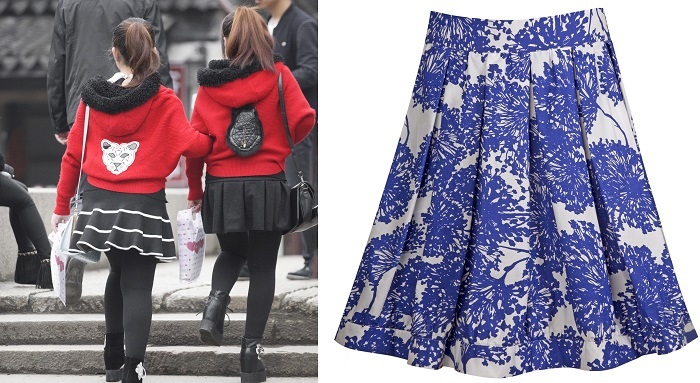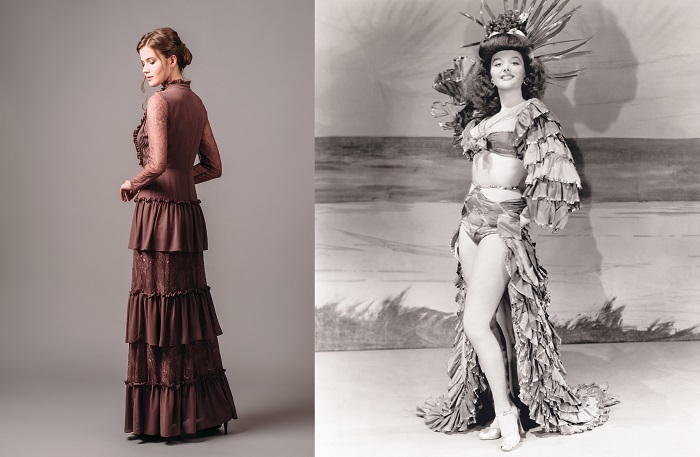

The additional fabric used to cover the drape’s width and occasionally its height is known as “fullness.” A drape with more fullness has a richer appearance. It offers additional light and sound absorption as well as an increase in the depth of field that may be seen. How much fullness to add to a drape depends on its usage, style, and price range. If seams need to be “hidden” within the pleat, there is another thing to think about. The meaning of “fullness” is that it helps achieve proper fit and comfort and is done to create variation. Fullness is released by pleats, tucks, and gathers; darts are used to create flat patterns; and fullness gives clothing more adornment.
Following are the major terminologies used as types
Pleats are folds in clothing made at equal intervals on the yoke, sleeves, and waistband of skirts to release fullness. Pleats are made at the top and smoothly flow down the bottom of the fabric. A final pleat’s size is three times as large as the material needed to create it. They usually range in size from 2.5 to 5 cm. They can be employed as a style detail and cause eye movement.

Depending on the fabric chosen, a pleat has a different effect. The depth of the pleat is determined by the fabric’s weight and the desired look. Knife, Box, Inverted, Accordion, Sun Ray, Pinch, and Kick pleats are a few examples of the various pleat styles.
A ruffle is a fabric strip that has been trimmed or handled in a way that creates fullness. These are employed in order to embellish clothing. They can occasionally be used to lengthen the hems of skirts and dresses.

To create flare and add ornamentation, frills can be gathered or pleated and cut on a straight, bias, or circular axis. It is crucial to leave enough fullness for gathering, but how much should be left depends on the fabric type. They can be used to trim the neckline, wrists, and hem of a garment either individually or in tiers. Ruffles and frills are best made from light-weight, sheer fabrics.
A dart is a triangular fold that is crucial when manufacturing clothes. It contours a flat piece of cloth to fit the natural curves of the body’s bust, armholes, neckline, and waist. They are primarily used in clothing for women. They are essential when designing clothing and cannot be disregarded. In the process of making darts, the stitching should begin at the broad edge and travel toward the tip. Normally, darts are made before a garment is sewn. It aids in improving the fit of the clothing. Single-pointed darts and double-pointed darts are the two different varieties of darts.
A tuck is a fold in the cloth that is sewn down to give the garment more fullness. They should have an even width and aid in shaping a garment. Depending on whether the garment is used for ornamental or functional purposes, tucks can be done on either the right or wrong side of the garment. They produce a decorative accent that gives clothing more fullness. They appear more alluring when wearing exquisite and delicate fabrics. They ought to be separated equally. The various tuck styles include the pin, cross, piped, and shell tucks.
Gathers are used to distribute fullness evenly in a specific area. Depending on the desired impact, the material requirement can be adjusted to be twice as wide. Cotton that is stiff has a crisp look, whereas silk or any man-made fibre has a graceful one. Elastic, a machine, or a hand can be used to gather material. Using the sewing technique of “gathering,” a fabric strip can be made shorter so that it can be joined to a shorter piece. It is frequently used to manage fullness in clothes, such as when a full sleeve is attached to a shirt’s armscye or cuff or when a skirt is fastened to a body.
A godet is an additional piece of cloth sewn onto a garment, typically a dress or skirt, in the shape of a circular sector. When a godet is added, the item of clothing in question flares, adding width and volume. A godet gives a piece of clothing added range of motion for the wearer.
According to current fashion trends, flares can be added to skirts, sleeves, trouser legs, and other garments. To add diversity, you can change the degree of flare. For instance, an A-line skirt has the least amount of flare at the hem, while a circle skirt has the most. Bell sleeves have a modest flair, whereas circular sleeves have the most flare.
Shirring, which is made up of several rows of gathers, is a technique for producing regulated fullness, such as at the waistline, cuffs, or bodice yoke. In order to prevent stress on the numerous thread rows, it is frequently stabilised and embellished with decorative stitching or smocking. Similar to gathering, shirring involves stitching many parallel rows rather than just one. For the finest appearance, all threads must be sized up at once. To ensure that no rows come loose, it is crucial to knot off threads firmly. When the shirring is finished, the underside can be stabilised with a flat fabric for optimum security while still maintaining its entirely aesthetic nature.
To create a fitted bodice or hip and a flared-out hem, gores can be added to a skirt, kameez, or top. The type and availability of the fabric, the grain, and the desired level of fullness for the hemline all affect how many gores are inserted. It can be anywhere from 4 and 12; either 6 in the front and 6 in the rear, or 2 in the front and 2 in the back. In order for gored skirts or dresses to drape properly, the grain line is crucial. In order to achieve a decent, uniformly distributed flare and an appropriate slant on the seams, the centre of the gore should be on the straight grain.
To sum up, fullness makes a cloth look appealing and helps it accommodate the body’s natural curves. The contour is shaped by darts. Any area of the garment can be made fuller by pleating, gathering, or tucking. The type of material determines the choice of fullness.